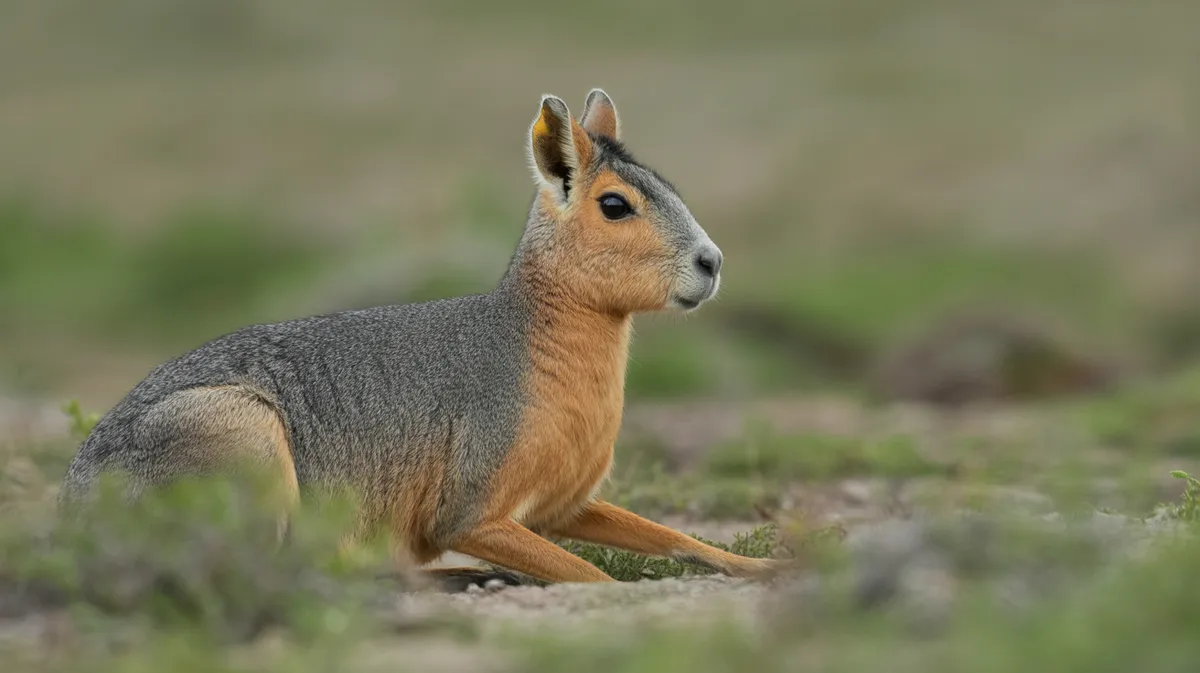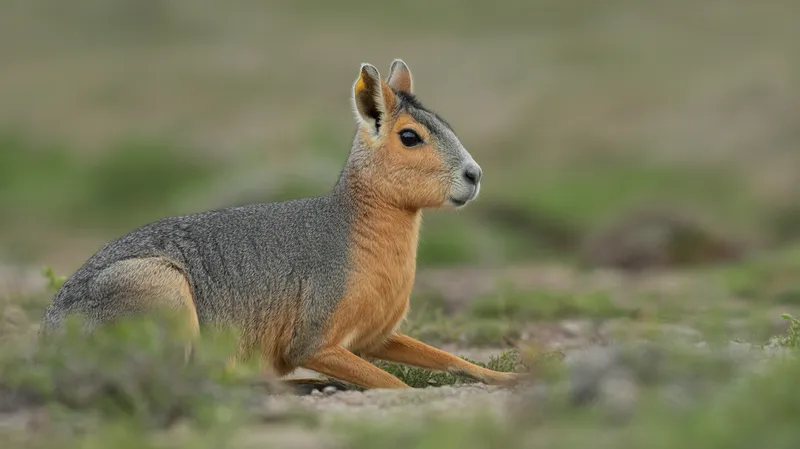
Patagonian Mara
Dolichotis patagonum

Meet the Patagonian Mara
The Patagonian Mara is a large, herbivorous rodent native to the open and semi-open habitats of central and southern Argentina. Resembling a cross between a rabbit and a small deer, it has long legs adapted for fast running and strong hindquarters for powerful leaps. Patagonian Maras are monogamous, often forming lifelong pairs, but can also be seen in large groups when feeding or raising young. They are diurnal and primarily graze on grasses and other vegetation, playing an important role in their ecosystem.
Classification
Mammal
Habitat
Grasslands and shrublands of central and southern Argentina
Diet
Herbivore
Lifespan
8-14 years
Conservation
Near Threatened
Weight
8–16 kg
📖Fascinating Facts
Fast Runners
Patagonian Maras can reach speeds of up to 45 km/h, using their long legs to escape predators across open grasslands.
Monogamous Pairs
Unlike most rodents, Patagonian Maras form lifelong monogamous pairs, often sharing the duties of raising their young.
Grassland Herbivores
Their diet consists mainly of grasses, herbs, and occasionally fruits, making them important grazers in their native habitat.
📋Detailed Description
The Patagonian mara (Dolichotis patagonum) is a large, cursorial rodent endemic to the arid and semi-arid regions of central and southern Argentina, particularly the Patagonian steppe. Adults typically measure 69–75 cm in length and weigh between 8 and 16 kg, making them the fourth largest rodent species globally. Their body is slender with long, powerful hind limbs adapted for running and leaping, reminiscent of small ungulates, while the forelimbs are shorter and equipped with sharp claws for digging. The fur is dense and coarse, colored gray-brown dorsally with a white underside and a distinctive white rump patch. Maras have large, rabbit-like ears and a short, almost vestigial tail. They are primarily diurnal, exhibiting peak activity during early morning and late afternoon to avoid midday heat. Socially, maras are unique among rodents for their monogamous pair bonds, with pairs often maintaining lifelong associations. However, they display a complex social structure, forming temporary aggregations of up to 70 individuals at communal breeding warrens. Their diet consists mainly of grasses, herbs, and some shrubs, and they play a crucial role as grazers in their ecosystem. Patagonian maras are highly vigilant, relying on keen eyesight and rapid, bounding locomotion to evade predators such as foxes, birds of prey, and introduced species like domestic dogs.
💡 Did you know?
Despite being rodents, Patagonian Maras have long, slender legs and can hop like a rabbit, making their movement quite unique among mammals.
🔬Research & Sources
Wikipedia Summary
The Patagonian mara is a relatively large rodent in the mara genus Dolichotis. It is also known as the Patagonian cavy or Patagonian hare. This herbivorous, somewhat rabbit-like animal is found in open and semiopen habitats in Argentina, including large parts of Patagonia. It is monogamous, but often breeds in warrens shared by several pairs.
Last Modified: 5/8/2025
🎭Behavior & Social Structure
Patagonian maras are primarily terrestrial and exhibit a range of locomotive behaviors, including walking, trotting, and a distinctive bounding gait called 'stotting' when alarmed. They are highly vigilant, often standing upright on their hind legs to scan for danger. Feeding occurs mainly during daylight hours, with individuals grazing on a variety of grasses and forbs. Maras are known for their strong pair bonds; pairs maintain close proximity, often grooming each other and engaging in coordinated vigilance. Despite monogamy, they are semi-colonial, with multiple pairs sharing communal burrow systems for breeding. Outside the breeding season, maras may form loose foraging groups, which provides additional protection against predators. They communicate through a variety of vocalizations, foot thumping, and scent marking using anal glands. Territoriality is exhibited primarily during the breeding season, with pairs defending the immediate vicinity of their warren.
👶Reproduction & Life Cycle
Patagonian maras are seasonally monogamous, with breeding typically occurring from August to January, coinciding with the austral spring and summer. Females give birth to one to three litters per year, each consisting of 1–3 precocial young (average 2). Gestation lasts approximately 90 days. Unlike most rodents, maras use communal breeding dens or warrens, where multiple pairs rear their young in close proximity. After birth, the young remain in the warren, which provides protection from predators, while mothers visit to nurse them several times a day. Both parents participate in vigilance and defense of the warren. Weaning occurs at around 75–90 days, after which juveniles gradually become independent. High predation rates on juveniles are offset by the communal care system and synchronized breeding, which may overwhelm predators through sheer numbers.
🛡️Adaptations & Survival
Patagonian maras possess several adaptations for survival in open, arid environments. Their long, slender legs and reduced toes are specialized for fast, efficient running and leaping, enabling them to escape predators over long distances. The dense, coarse fur provides insulation against temperature extremes and protection from abrasive vegetation. Their large eyes and ears enhance vigilance and predator detection. Socially, monogamy and communal breeding are rare among rodents and may have evolved to maximize offspring survival in habitats with high predation risk. Physiologically, maras have a specialized digestive system with an enlarged cecum, allowing efficient extraction of nutrients from fibrous, low-quality vegetation. They also practice coprophagy (re-ingestion of feces) to maximize nutrient absorption.
🎨Cultural Significance
While not a major figure in indigenous mythology, the Patagonian mara is recognized in local folklore and is sometimes referred to as 'liebre patagónica' (Patagonian hare) due to its superficial resemblance to hares. In some rural areas, maras have been hunted for food, though this is less common today. They are increasingly featured in ecotourism and wildlife education programs, serving as a flagship species for Patagonian grassland conservation. Their unique appearance and social behavior have also made them popular in zoological collections worldwide.
🔬Recent Research & Discoveries
Recent research on Patagonian maras has focused on their social structure, reproductive strategies, and responses to habitat modification. Studies using GPS telemetry and camera traps have revealed detailed movement patterns and habitat preferences, highlighting the importance of undisturbed grasslands for their survival. Genetic studies have explored population structure and the impact of habitat fragmentation. Behavioral ecologists have investigated the evolution of monogamy and communal breeding, providing insights into the adaptive significance of these traits. Ongoing research is examining the effects of climate change and land-use practices on mara populations, as well as their role in grassland ecosystem functioning.
🎥Wildlife Videos

Patagonian Mara - 5 Minute Documentary
Embark on an enchanting five-minute documentary journey into the windswept plains of Patagonia, where the remarkable ...
Five Minute Documentaries

Have You Ever Seen A Patagonia Mara? | A Land Unknown
Valdez Peninsula, a wedge of Patagonia that juts out into Argentina's Atlantic seaboard is probably the richest area for wildlife in ...
Real Wild

The Animals Of Patagonia Wildlife Documentary | Real Wild
Valdez Peninsula, a wedge of Patagonia that juts out into Argentina's Atlantic seaboard is probably the richest area for wildlife in ...
Real Wild

WILD PATAGONIA | The Mysteries of Earth's Last Untamed Ecosystem | Animal Documentary
Patagonia, a vast and windswept region straddling the southernmost reaches of South America, is one of the planet's most ...
WILD Nature - Free Documentary

The Secret Life of the Patagonian Mara
Meet one of South America's most fascinating animals: the Patagonian Mara! These sleek, long-legged creatures may look like ...
The Story of Animals

The Patagonian Mara Is a Rodent on the Run
The Patagonian mara looks like a cross between a deer and a rabbit, but it's actually a rodent. These little guys are only found in ...
Great Big Story
🌍Habitat Information
The Patagonian Mara typically inhabits Grasslands and shrublands of central and southern Argentina environments. Patagonian Maras have adapted to their environments with specialized features and behaviors.
Primary Habitat:
Grasslands and shrublands of central and southern Argentina
More detailed habitat information will be available soon.
🛡️Conservation Status
The Patagonian Mara is currently classified as Near Threatened. Conservation efforts are crucial for preserving this species for future generations.
Common Threats:
- 🏠Habitat loss and fragmentation
- 🌡️Climate change impacts
- 🎯Hunting and poaching
- 🏭Human-wildlife conflict
⚠️Threats & Conservation Challenges
The primary threats to Patagonian maras include habitat loss and fragmentation due to agricultural expansion, overgrazing by livestock, and competition with introduced herbivores such as European hares and domestic sheep. Predation by native and introduced carnivores (e.g., foxes, dogs) also impacts populations, particularly juveniles. Additionally, maras are sometimes hunted for meat or captured for the pet trade. Population trends indicate a decline in many areas, leading to their classification as Near Threatened by the IUCN. Conservation challenges include the need for habitat protection, sustainable land management, and mitigation of human-wildlife conflict.
🔬Scientific Classification
Scientific Name
Dolichotis patagonum
Classification Hierarchy
🔍 About Taxonomic Classification
Taxonomic classification is a hierarchical system used by scientists to classify and organize living organisms based on shared characteristics and evolutionary relationships.
The system moves from broad categories (Kingdom) to increasingly specific ones, with each animal's scientific name typically consisting of its Genus and species.
📝Community Notes
Share your observations and insights about the Patagonian Mara with our community of wildlife enthusiasts.
Join Our Community
Sign in to share your observations and connect with fellow wildlife enthusiasts.
Sign In to ContributeNo community notes yet
Be the first to share your observations about the Patagonian Mara!
Explore Patagonian Mara
Select a tab above to learn more about this amazing animal.
📸Photo Gallery
No photos available for this animal yet.
🌟Discover More Wildlife
Continue your journey of discovery with more fascinating animals from our database
